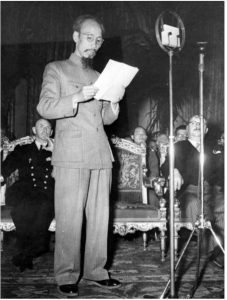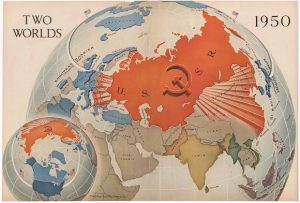49 Perspectives on the Vietnamese/American War by Sophie Briggs
1. Identifying perspectives on intervention in Vietnam (1945-1956)

President of the Republic of Vietnam Ho Chi Minh, speaks at the City Hall, Paris, July 4, 1946, during negotiations with the French, by Associated Press, (editorial use only).
| Curriculum Context | Unit 2 Modern History, Area of Study 1 (VCAA, 2020) |
| Historical Context | The Cold War > Proxy wars and conflicts that reflected the consequences of tensions and divisions of the Cold War > The Vietnam War |
| Historical Thinking Concepts | Analyse sources for use as evidence
Identify the perspectives of people and how perspectives changed over time |
| Learning Intentions | Use historical knowledge to identify perspectives within primary sources
Contextualise the causes of the Vietnam War within the Cold War world Develop understandings of the impact and perceptions of foreign intervention on the Vietnamese people and the emergence of an independent Vietnam |
Activity
Students will conduct a Big Paper activity (Facing History & Ourselves, 2008), silently annotating and analysing one of three sources representing varied perspectives in groups of no more than four. This activity allows students to collaborate in identifying differing perspectives on intervention in Vietnam between 1945 and 1956 drawn from primary source evidence. Students will begin to develop interpretations of how and why American, Russian and Chinese Cold War tensions played out in Vietnam and consider this proxy war not only in the global Cold War context but also contemplate the war from the perspective of the Vietnamese people in the context of decolonisation and self-determination.
Suggested Sources
Ho Chi Minh’s Declaration of Independence (1945)
America’s acknowledgement of Vietnamese Independence (1950)
Le Duan on Communist revolution in South Vietnam (1956)
Part 1: Big Paper activity
Each group will be given a large sheet of paper with a primary source in the centre. In small groups, read and then silently annotate and analyse your source. Drawing on prior knowledge of the Cold War world and the situation in Vietnam during this period, you should annotate your source with connections to historical knowledge, perspectives identified, and questions you might have. You may add on to the ideas of others already on the big paper or contribute your own ideas. Each group member should contribute at least four annotations to the paper.
Each group will now move to another group’s big paper with a different source to their own. Read the new source and the annotations, then add any questions, thoughts, connections, or ideas of your own to the paper. Each group member should contribute at least one annotation to the paper. When instructed, move to the next group’s paper, and repeat the process with their source. Each group will now have had a chance to read and annotate all three sources.
Part 2: Whole Class Discussion
Your teacher will lead a whole class discussion on the findings from the Big Paper activity, devoting discussion time to each source in turn. Each group’s paper will be displayed on the wall or whiteboard during the discussion.
Part 3: Exit Ticket
Write a reflection on this activity, addressing the following questions:
- What did independence mean to Ho Chi Minh in Vietnam post-French colonisation?
- How did the U.S. see Vietnamese independence?
- How did Le Duan perceive the “democratic” government of South Vietnam?
- What was your main take away from this activity?
References
Alpha History. (n.d.). Ho Chi Minh’s Declaration of Independence (1945). https://alphahistory.com/vietnamwar/ho-chi-minh-declaration-independence-1945/
Alpha History. (n.d.). Le Duan on Communist revolution in South Vietnam (1956). https://alphahistory.com/vietnamwar/le-duan-communist-revolution-195/
Alpha History. (n.d.). The US recognises Vietnam (1950). https://alphahistory.com/vietnamwar/us-recognises-vietnam-1950/
Facing History and Ourselves. (2008). Big paper: building a silent conversation. https://www.facinghistory.org/resource-library/big-paper-building-silent-conversation
VCAA. (2020). VCE Study Design: History 2022-2026. Victorian Curriculum and Assessment Authority. https://www.vcaa.vic.edu.au/curriculum/vce/vce-study-designs/history/Pages/index.aspx
2. Comparing American and North Vietnamese perspectives on intervention in Vietnam: Fishbowl discussion

Two Worlds by Robert M. Chapin, Public Domain
| Curriculum Context | Unit 2 Modern History, Area of Study 1 (VCAA, 2020) |
| Historical Context | The Cold War > Proxy wars and conflicts that reflected the consequences of tensions and divisions of the Cold War > The Vietnam War |
| Historical Thinking Concepts | Construct arguments about the causes and consequences of the Cold War using sources as evidence |
| Learning Intentions | Use historical knowledge to construct arguments and historical interpretations about the causes of the Vietnam War
Understand how different perspectives can affect interpretations of historical events Exercise empathy when considering different perspectives
|
Activity
Students will participate in a fishbowl discussion (Facing History & Ourselves, 2009) exploring American and North Vietnamese perspectives on the causes of the Vietnam War drawing on prior knowledge of events, ideology, and primary sources studied in class. Students will practice historical skills while also exploring how different perspectives influence the way in which historical events are interpreted by taking the position of one perspective in the discussion. This activity provides students an opportunity to practise the skills of historians by constructing arguments based on historical knowledge, while also exercising empathy as they embody differing perspectives.
Part 1: Preparation
You will be split into two groups: American and North Vietnamese. Prior to the discussion, you will prepare arguments from your assigned perspective about why the Vietnam War occurred. You should draw on your prior knowledge of events, ideology, and primary sources studied in class. Remember to consider only arguments that support your perspective!
Part 2: Fishbowl discussion
You will form two circles, one group on the inner circle, one on the outer circle. The inner circle will begin the discussion, arguing their perspective on the causes of the Vietnam War. The outer circle should observe and take notes on the discussion. After fifteen minutes, the discussion will end. Before switching groups, add one observation, thought, or idea from your notes on the first group’s discussion to the mind map on the whiteboard under the appropriate perspective’s heading. All students should add at least one idea to the mind map.
Groups will then switch places and repeat the process with the other perspective. At the end of the fishbowl discussion, both perspectives have been articulated and there will be two mind maps on the whiteboard outlining the key ideas from each perspective.
You should have a set of notes reflecting each perspective from participating in and observing the discussion.
Part 3: Whole class discussion
Your teacher will lead a whole class discussion using the mind maps on the whiteboard to stimulate discussion. Add any new ideas from the mind map to your own notes, paying close attention to similarities, differences, and contradictions in the differing perspectives.
Part 4: Written reflection
Write a reflection addressing the following two topics. You should use formal academic writing conventions, writing in full sentences and paragraphs and referring to events, people, places, ideology, primary sources, and dates where appropriate.
- Imagine you are a historian writing about the causes of the Vietnam War for a school textbook. Using your knowledge of differing perspectives, how would you explain the causes of the war?
- What have you learned about how perspectives colour our interpretation of historical events?
References
Facing History & Ourselves. (2009). Fishbowl. https://www.facinghistory.org/resource-library/fishbowl
VCAA. (2020). VCE Study Design: History 2022-2026. Victorian Curriculum and Assessment Authority. https://www.vcaa.vic.edu.au/curriculum/vce/vce-study-designs/history/Pages/index.aspx

